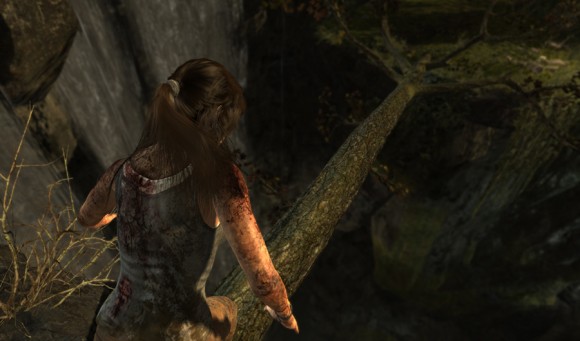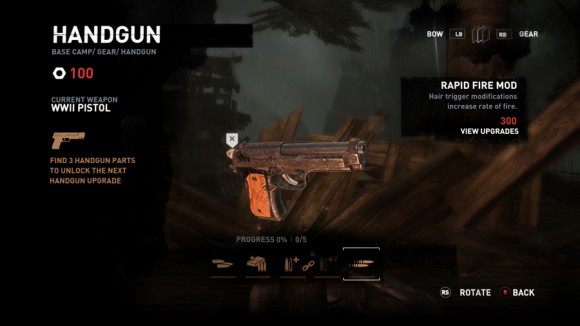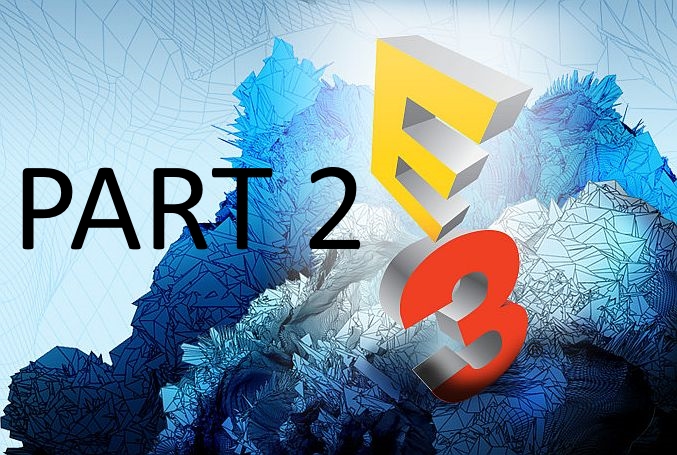Mainstream
Tomb Raider Review

 Unlike a lot of male gamers who grew up in the 90’s and early 2000’s, I’ve never really understood the appeal of the Tomb Raider series. Granted, the only one I really played more than an hour of was Tomb Raider: Legend on my PSP, which I found that to be mediocre at best and downright frustrating at worst; the rest of the series seemed to me to be nothing more than eye candy for horny teenagers guised in a thin veil of an adventure game. I’ve never even understood why everybody ogled over Lara Croft so much, other than the obvious fact that she was created primarily as a video game sex symbol. Beyond this though, you often hear gamers talking about how awesome of a character Lara is, even though, from my perspective, she has always a “Mary Sue” who is perfect in every way, and completely dull all around.
Unlike a lot of male gamers who grew up in the 90’s and early 2000’s, I’ve never really understood the appeal of the Tomb Raider series. Granted, the only one I really played more than an hour of was Tomb Raider: Legend on my PSP, which I found that to be mediocre at best and downright frustrating at worst; the rest of the series seemed to me to be nothing more than eye candy for horny teenagers guised in a thin veil of an adventure game. I’ve never even understood why everybody ogled over Lara Croft so much, other than the obvious fact that she was created primarily as a video game sex symbol. Beyond this though, you often hear gamers talking about how awesome of a character Lara is, even though, from my perspective, she has always a “Mary Sue” who is perfect in every way, and completely dull all around.
I’ve even heard people praise Lara for being a “strong female character”, even though she’s probably done more to harm the depiction of female game characters and, by extension, gaming as a whole than any other female lead. Like I touched on before, I have little experience with past Tomb Raider games, so my opinion may be completely unjust, but either way this the image of Lara Croft that has been conveyed to the masses not only by the media, but by the game’s own marketing strategies. So, that said, is Tomb Raider any good? Does this reboot take the series in a new direction? Is Lara Croft finally a character with some substance, rather than just a pair of butt-kicking breasts? Well, allow me to answer these questions with an emphatic YES!
I’ll start off by saying that when I first heard Crystal Dynamics would be rebooting the stale Tomb Raider series, I was cautiously optimistic. For all of the harsh words I’ve said about Lara Croft as a character, I’ve actually seen a lot of potential for her to become a strong female lead, and with this new reboot I can finally say that Lara has become not only one of the best female video game characters ever, but one of the best game characters of any sex or gender. Rather than being a flawless Mary-Sue, her flaws are laid out for the world to see; she has her weaknesses, she has her limits, and she actually feels like a human being rather than a robotic analogue. As the story progresses and Lara endures more hardships, her personality undergoes quite the metamorphoses, transforming her from a sort of traveling scholar who relies on the strength of others, to a full-fledged survivor and adventurer that has gradually discovered strength within herself.
Beyond this, the developers managed craft her personality in such a way as to show just how strong and determined she is, without falling in to the oft sprung trap of giving her traits that are more commonly associated with masculinity. It’s incredibly refreshing to finally play as a strong female character that doesn’t have a stereotypical male persona or is devoid of personality entirely. I absolutely adore the way in which the developers managed to give Lara the strength needed to accomplish her goals, without sacrificing any of her femininity.
Of course, having a strong protagonist doesn’t automatically equate to a good game, but I can honestly say that Crystal Dynamics has hit this one out of the park. The story opens with Lara on an expedition to find the lost island kingdom of Yamatai which is said to have been ruled by a Sun Queen who could control the weather. During a particularly fierce storm, her ship is torn apart and she is separated from her shipmates. Lara makes her way to a nearby island and begins to search for the ship’s crew. However, things are never that easy and turn downright dangerous when a Sun Queen-worshipping cult called the Solarii begin kidnapping and killing Lara’s friends.
When Lara is alone, the story is spectacular, well executed, and has great pacing and story progression. We clearly see the multitude of conflicts on display as you progress through the game, and furthermore we see the effect each has upon Lara; there is one scene towards the end of the game where you come across a mirror and you watch as Lara stares at herself for a moment. In her eyes you can clearly see that she isn’t the same person who arrived on the island. The old fiction writer’s adage of “if you love your characters, put them through hell” was taken into great account; we see and feel each injury, each near death experience, and each of them appeals greatly to our own base fears. This leads to an unbelievable amount of immersion that causes you to project your own consciousness into Lara; as such, you develop a deeper understanding of who she is, why she is fighting, and how she becomes so strong.
Conversely to this, the other characters are pretty bland, which unfortunately leaves a few gaping holes in an otherwise decent story. For one, all of the other characters are your typical cookie-cutter archetypes with zero character development and no depth; though I will laud the developer’s attempt at a racially diverse cast, even if these characters do fall short. This is too bad because it detracts from the relationship between Lara and the player; you’re never able to empathize with anyone else and as such, can never truly understand the ferocity in which Lara fights for them, aside from her internal conflict about being the one who led them on the failed expedition. Thinking more critically on the matter though, this poor character interaction may actually work in Tomb Raider’s favor. Since one of the main themes of the narrative is relying solely on yourself and your instincts; having the other characters be more fleshed out and fully realized might actually detract from the disconnect towards other people that grows within Lara as her character evolves.
Another thing that annoyed me with Tomb Raider’s story is that it continuously uses the trope of having the characters split up for some obligatory reason. There’s a point near the beginning of the game where almost all of the characters are reunited, but then they decide to break off into groups for a reason I honestly can’t remember. If you and a bunch of other people were stranded on an unfamiliar island, would you make the conscious decision to split up? I didn’t think so.

So, I was thinking. How ’bout you go climb up that mountain to look for the others, and I’ll stay back here and eat chips. That’s fair, right?
Gameplay wise, Tomb Raider is similar to the Uncharted series in that it has you swapping between climbing/puzzle solving, and third-person shooting. One of the aspects of the game I was most excited about was the idea of surviving in the wilderness. Unfortunately, this didn’t play as big of a role as I had initially thought it would, and the game turned out to be more of an action epic, than a survival game. Tomb Raider has you climbing cliff faces and ancient ruins like you’d expect, but it also has you exploiting your surroundings to take out your enemies and traverse the island. Climbing around jumping from ledge to ledge has never been more fun and varied, and using your climbing axe to work your way up the face of a rock is strangely satisfying and never dull.
Combat feels very natural and is rarely frustrating. Technically, you only have four weapons to choose from when dispatching your enemies: five if you count the climbing axe. Among these are a bow, a pistol, a machine gun, and a shotgun. Each weapon has various upgrades that increase its damage, reload speed, firing rate, and more; you can upgrade your weapons by collecting, and subsequently spending, “salvage” from special boxes scattered around each level, or from enemy and animal corpses after you have unlocked a certain skill; you can also find weapon parts to increase their stats even more. After a while, your arsenal begins to serve other purposes than just killing people and animals. For example, the shotgun can bust through some debris to allow you to pass by; the bow has a rope arrow feature that can be used to string up zip lines, latch onto rope covered objects from a distance so you can pull them towards you, or even open certain doors. These secondary uses for your weaponry give the game a sort of “metroidvania” feel that is always welcome in my opinion.
Killing an enemy or animal, finding a hidden item, or reaching a certain point in the game yields experience points which eventually add up to a skill point that you can spend on a skill in one of three categories: hunter, survivor, or brawler. These skills allow you to do different things such as the ability to collect salvage from fallen enemies, increase your maximum ammo capacity, allow you to attack with your climbing axe, etc. Apart from the aforementioned methods, you can also gain XP and salvage by completing a multitude of side challenges; completing these challenges is completely optional, unless you want to finish the game with all your skills and weapons maxed out. Apart from the main story or the challenges therein, there are also tombs in which you can explore to find more XP, salvage, and weapon parts. These tombs are basically just a separate room with a puzzle to solve; I guess the developers thought the main game was too devoid of puzzles, which admittedly is true, though that’s not necessarily a bad thing.
The subject of violence is approached in a careful, yet effective way and I have to give huge props to Crystal Dynamics for not pulling any punches. The violence in Tomb Raider is mostly born from how many people you have to kill, however, unlike previous entries in the series, you get a sense of the effects that the act of ending this many lives has on Lara’s psyche. The first time she has to kill someone, she becomes distraught and sick to the point of almost throwing-up, but after a while she becomes desensitized to the act of killing, and even comments on how frighteningly easy it actually is. I was also worried that because Lara is a woman, the developers might feel obligated to omit any violent acts done to her which, in my opinion, would be quite sexist. There’s one scene in particular where a group of men beat the crap out of her; taken out of context, this could easily be seen as a male dominance fantasy, but when you take a more intellectual look and don’t jump to conclusions, you can see that this isn’t the case. Think about it, by this point in the game Lara has killed at least 50 of these men’s fellow cult members, and was just about to kill all of them until she was forced to drop her weapons at the threat of her friend being killed. The fact that she’s a woman has nothing to do with the scene in question, and I applaud the tactful way in which it was executed.
The death animations are particularly brutal, and at first seem somewhat out of place with the overall tone of the game. However, I think this was a good design choice on the part of the developers because it depicts a more realistic, albeit gruesome, fate that could potentially happen to someone in a survival situation. Unlike a lot of M rated games, Tomb Raider isn’t really all that violent in terms of blood and gore or killing in a grizzly fashion, but rather it has instances that are far less “cartoony” and much more likely to happen in real life. I can witness people getting chainsawed in half in Gears of War and not bat an eyelash due to how unrealistic is, but when I mess up and see Lara getting impaled through the skull from under chin to crown of head, I can actually feel it.
Aesthetically, Tomb Raider simply looks fantastic and was clearly created with painstaking detail. Aside from collectables, nothing looks deliberately placed; rather, the game has a very organic feel that is furthered by the exemplary visuals and highly polished graphics. Issues such as screen tearing, visual artifacts, lighting/shading issues, clipping, and texture pop-in are few and far between, so it’s clear that Crystal Dynamics put a lot of love and effort into this project.
The opening gameplay sequence is very fast paced and exhilarating, to the point that afterwards I actually felt my heart beating faster than normal, and even felt short of breath. This is a perfect way to draw players into the game while giving them only a fraction of the truly epic and adrenaline packed moments that are to come, as well as setting up the exasperating crescendo of an ending that is quite satisfying and will leave you with a sense that you had just finished an amazing adventure; mostly because you have.
The only real downside to Tomb Raider is the cutscenes. While they aren’t terrible, they do clash heavily with the gameplay sections in that they are very mechanical and forced compared to the fluid nature of the gameplay, and as such, the resulting transition between the two is quite jarring.
Tomb Raider’s already glimmering coat of polish is further waxed by a slew of great design choices and game mechanics. One of these is an ability called “Survivor Instinct” that allows you to see important items and key parts of your surroundings. This is very useful if you get stuck in an area and cannot discern where to go, or you are just on the lookout for items of interest and enemies. It’s also nice that you can fast travel between different campsites so you can go back and collect items that you may have missed or could not acquire when you were initially there. The interface of the game is very simple and clean, with no unnecessary distractions; I always like games that don’t have a HUD present to obstruct the screen. All of this is wrapped up with controls that feel both precise and natural, and give the game a sense of fluidity that few others have achieved.
I’ll just go on record and say that I absolutely adore Tomb Raider. This is by far the best entry in the series, and is easily my favorite game so far this year; sorry Ni No Kuni. There are a handful of flaws that prevent this from being a true masterpiece, but certainly not enough to detract from the overall enjoyment that is to be had. Lara Croft is finally a truly great character, female or otherwise, and has now raised the bar of video game character development that other developers will be hard pressed to overcome. Here’s to hoping Crystal Dynamics can further refine this new formula, and come up with new and interesting ways in which to explore Lara Croft’s character.
Final Rating:
Gaming News
Best Usenet Newsgroups for Gaming

Usenet newsgroups may seem old-fashioned to many. In reality, they are the perfect place for players who love the classics but are always open to new games and strategies. These internet communities are also ideal for those searching for gaming material, solutions to issues, or a conversation related to their favorite video games. Whether you are an experienced player or entering this domain for the first time, Usenet holds a ton of resources that could change how you interact with the gaming world.
Understanding Usenet Newsgroups
Usenet newsgroups, which include gaming groups, are like message boards. People can post messages and articles in different categories. Each group is a special place for certain topics – this makes it simple to find the subjects you want to read about most. The unique characteristic of Usenet lies in its decentralized structure. This permits a much more open interchange of details and information than what is seen on regular social media platforms or forums.
Initially, Usenet was utilized only for academic and professional exchanges. However, it soon turned into a prevalent method for communicating among hobbyists and gaming groups. Presently, even though Usenet has been surpassed by newer platforms in terms of popularity, it continues to be an important tool for knowledgeable users who value its special mix of staying anonymous with fast communication. Knowledgeable users also love access to vast archives containing historical information and software applications that are no longer available elsewhere on the Internet.
Top Usenet Newsgroups for Mobile Games
comp.mobile.games
This is a fresh group dedicated to discussions about mobile games and related technology matters within the industry. Here, you can find conversations about the coding aspects of creating games for mobile devices, like new updates in platforms or fresh game engines being used for development purposes.
rec.games.mobile
The perfect place for people who play games on their mobile devices as a hobby. Here, users talk about strategies, tricks and discuss game evaluations. This group is also suitable for those who are not serious gamers but like to connect with others and discuss playing strategies.
alt.games.mobile
In this newsgroup, users often discuss gaming fixes and give each other suggestions. It is also the go-to place for gamers and die-hard fans that wish to find each and every detail of the game they love to play.
Best Newsgroups for Video Game Discussions
Newsgroups such as alt.games.video and rec.games.video.arcade have lively communities where gamers often engage in exchanges and conversations. These forums are not only for resolving gaming issues or writing reviews; they are centers of enthusiastic discussion regarding gaming culture, strategy, and creation process. Be it the latest RPGs, energetic shooters or old-school arcade games – there is always a thread bustling with discussion.
In these threads, not only will you encounter a variety of views from across the globe, but you may also land on gaming tricks and shortcuts that are lesser known. For those who are new, remember that every group has its own tone and rules. Lurking for a while should help you understand community norms and ensure your contributions are accepted.
Specialized Gaming Newsgroups
Specialized newsgroups are designed for particular gaming communities. They provide a discussion environment that is more centered and focused. These groups are ideal for users who really love a particular game and want to explore it in great depth.
The benefit of these specific groups is their collection of very particular details. Gamers who are part of such a group often exchange unique things like custom mods or skins, and offer advice on how to make gameplay more efficient and fun.
Tips for Using Usenet Newsgroups for Gaming
To enter Usenet, you will first need to pick a provider that is well-known for security, high retention rates and fast speed. To make the right pick, it is a good idea to get the rankings for the best Usenet providers. Next, get advanced newsreader software, as this will allow you to browse through newsgroups easily and manage your activities effectively.
Focus on newsgroups related to gaming and participate in discussions matching your interests to find gaming buddies. Also, make sure that you follow the netiquette of each group while doing so. Utilize newsreader software functions like filters and automation to keep things simple.
Conclusion
Usenet, at first sight, can appear as a choice for oldies or people that have not yet acclimated to social media platforms and forums. However, its distinct characteristics make it very useful for all kinds of gamers. If you are searching for uncommon information, looking for detailed conversations or wish to join a community that matches with your specific interests; Usenet is surely the place for you. Jump in to see how Usenet can add another element of fun to your gaming experiences!
Casual
Encouraging Growth and Motivation: Resources for Child Development

Child development is a complex journey marked by critical milestones where each stride forward builds upon the foundation of the previous one. Acknowledging children’s individual needs, pediatric therapy services tailor strategies to foster physical, emotional, and cognitive growth. To support this transformative process, environments that prompt curiosity and engagement, coupled with advanced educational tools, play an instrumental role in shaping young minds. These resources, carefully selected and applied, can significantly amplify a child’s developmental trajectory. Keep reading to learn about the effective ways these tools and techniques can aid in advancing childhood milestones.
Pediatric Therapy Services: Enhancing Developmental Milestones
Pediatric therapy services support children as they reach and surpass developmental milestones. These services, often provided by skilled therapists, address various growth challenges, ensuring each child has the best possible start in life. From speech and occupational therapy to physical and behavioral interventions, these professionals tailor their approach to meet the unique needs of every young patient.
Therapists work relentlessly to motivate children, fostering an environment where milestones are not merely achieved but celebrated. Through personalized, one-on-one sessions, children gain the confidence and skills necessary to navigate their developmental journeys more easily. The trust between therapist and child is a solid foundation for consistent progress and paves the path for lifelong learning and adaptation.
Resource provision is a key component of pediatric therapy, equipping parents with the tools to continue therapy practices at home. Effective communication between therapists and families ensures a cohesive strategy that envelops the child’s daily routine, enhancing the therapy’s impact. It also allows parents to identify subtle progress, reinforcing their pivotal role in the child’s developmental success.
If you’re looking for pediatric therapy in your area, a simple Google search like “pediatric therapy Arizona” will help you find local providers and services tailored to your child’s needs, ensuring they receive the specialized care necessary for their development.
Optimizing Play Spaces: Creating Environments for Learning and Exploration
Optimized play spaces are vital platforms where children engage with their world, build skills, and unleash their creativity. Designers of such areas pay astute attention to elements that promote safe exploration and intellectual stimulation. A thoughtfully arranged play environment serves as a place of entertainment and a crucible for burgeoning development.
Professionals incorporate a variety of tactile and visual stimuli within play areas to cater to diverse developmental needs and interests. Stimulating sensory experiences is central to cognitive and motor skill refinement among younger populations. The intentional selection of colors, textures, and interactive features sparks curiosity and encourages physical activity, which is fundamental to healthy growth.
Accessibility remains paramount in creating play spaces, ensuring they cater to children across all abilities. Including adaptive resources within these environments demonstrates a commitment to inclusive development, allowing every child to participate and benefit from the joy and learning play offers. Such inclusiveness fosters a sense of community and belonging, which is essential for emotional and social development.
Affording children autonomy in their play advances self-directed learning and problem-solving capabilities. When children feel empowered to make choices within their play, they better understand their preferences and abilities, setting the stage for confidence and self-awareness — qualities that are instrumental as children grow and transition through life’s stages.
Additionally, incorporating elements like fake plants or outdoor plants from retailers like Nearly Natural outdoor plants into play spaces can enhance children’s sensory and aesthetic experience.
Interactive Learning Tools: Technology and Resources for Cognitive Development
Interactive learning tools harness technology’s power to solidify children’s cognitive development. These digital resources provide an array of engaging, educational content that aligns with critical thinking and problem-solving skills.
Software and applications designed for children’s learning capitalize on the allure of multimedia to capture young minds. Effective education solutions provide children with stimulating challenges that are age-appropriate and aligned with developmental targets.
The discerning use of educational technology in classrooms and homes can reinforce concepts and skills taught through traditional methods. It creates a harmonious blend of instruction and interactive play, thereby cementing a child’s understanding and retention of information.
Providers of such educational platforms are ever vigilant, updating content to reflect new educational strategies and the latest academic research. Thus, children equipped with these technological tools remain at the vanguard of current learning methodologies, all while engrossed in fun and dynamic ways.
Overall, caregivers and educators can provide comprehensive support for children’s developmental journeys by integrating pediatric therapy services, optimized play spaces, and interactive learning tools. These resources nurture their physical, emotional, and cognitive growth and cultivate a lifelong love for learning and exploration.
Features
Why Investing in Academics Is Investing in Yourself

The quest for knowledge and self-improvement through academic pursuits is more than just a milestone in life; it is a cornerstone of personal development and success. Committing resources to further education is not merely an expense; it is an investment with considerable returns that extend far beyond the classroom. Education equips us with the tools required to navigate an increasingly complex world, opening doors to opportunities and fostering personal growth. Keep reading to discover why allocating time and resources to your academics is a decision that pays dividends for a lifetime.
The Lifelong Returns of Investing in Your Education
Investing in education is akin to planting seeds that blossom into numerous opportunities. Beyond financial gains, education forms the bedrock for career success and personal fulfillment. It empowers individuals to pursue their passions, enhances job satisfaction, and boosts self-esteem through academic achievements. Education serves as a catalyst for social mobility, breaking cycles of poverty by equipping people with the skills needed to improve their lives and contribute positively to society.
This ripple effect extends to lower crime rates and increased civic engagement, benefiting communities at large. Beginning with scholarships for high school sophomores can provide the initial support needed to embark on this transformative journey. These opportunities signify a commitment to nurturing future leaders and fostering a culture of lifelong learning and achievement.
Personal Growth and Lifelong Learning Through Education
Education is a vital aspect of personal development, providing opportunities for growth, character building, and discovering passions and capabilities. It fosters resilience and adaptability, which are essential in all aspects of life. A strong educational foundation encourages lifelong learning, ensuring individuals remain relevant and proactive in their professional and personal lives.
Education also broadens perspectives, exposing individuals to diverse ideas, cultures, and worldviews, fostering empathy, cross-cultural understanding, and appreciation for the human experience. It also allows for critical assessment and engagement with the world from an informed standpoint. The journey through academia often involves self-discovery, helping students uncover their strengths, weaknesses, interests, and values, leading to a more fulfilled life with aligned choices and goals.
Expanding Your Horizons: The Social Benefits of Academics
Academic investment in education is about building social capital through interactions with peers, faculty, and industry professionals. These interactions foster communication skills and relationships, which are crucial for life stages. Extracurricular activities in academic settings provide platforms for students to express themselves, learn new skills, and take on leadership roles.
Collaborative projects and team-based assignments teach students the importance of teamwork, compromise, and collective pursuit of goals. Higher education institutions also serve as a microcosm of society, requiring social awareness and finesse to navigate the diverse cultural, economic, and ideological perspectives.
How Academic Achievement Propels Professional Success
Professional success often hinges on a blend of experiences and achievements, with academic accomplishments playing a crucial role. Excelling in academia fosters a strong work ethic and sharp time-management skills, highly valued in today’s job market. Employers frequently use academic credentials to gauge candidates, especially for specialized roles like those requiring an aa in paralegal studies, where in-depth knowledge is pivotal.
Moreover, higher education equips individuals with specialized knowledge and technical skills that are indispensable in complex roles. Critical thinking and problem-solving abilities, nurtured during academic pursuits, further enhance one’s capacity to tackle challenges creatively. The networks formed during academic years often open doors to valuable career opportunities through mentorships and connections.
Leveraging Educational Investments for Career Advancement Opportunities
Investing in education can significantly impact career advancement, as academic qualifications often lead to promotions, leadership roles, and exclusive professional circles. Continuous education can lead to specialized career paths with higher salaries and statuses, especially in evolving fields. Higher education institutions offer career services like resume-building workshops and job placement programs to help students transition from academia to the workforce effectively.
For those already in the workforce, further education can be a strategic move for career change or progression, with flexible online programs and part-time options allowing working professionals to pursue additional qualifications while maintaining their current positions.
Altogether, the investment in academics is a far-reaching decision that impacts not just your immediate circumstances, but your future potential. As you prioritize your academic pursuits, you build a stronger foundation for success in every aspect of life—professionally, personally, and socially.
-

 Guides5 years ago
Guides5 years ago6 Proven Ways to Get more Instagram Likes on your Business Account
-

 Mainstream10 years ago
Mainstream10 years agoBioWare: Mass Effect 4 to Benefit From Dropping Last-Gen, Will Not Share Template With Dragon Age: Inquisition
-

 Mainstream6 years ago
Mainstream6 years agoHow to Buy Property & Safe Houses in GTA 5 (Grand Theft Auto 5)
-

 Casual2 years ago
Casual2 years ago8 Ways to Fix Over-Extrusion and Under-Extrusion in 3D Printing
-

 Mainstream12 years ago
Mainstream12 years agoGuild Wars 2: The eSports Dream and the sPvP Tragedy
-

 Guides10 months ago
Guides10 months agoFree Fire vs PUBG: Comparing Graphics, Gameplay, and More
-

 iOS Games2 years ago
iOS Games2 years agoThe Best Basketball Games for IOS
-

 Gaming News1 year ago
Gaming News1 year agoSwiping, Tapping, and Tilting: How Mobile Games Are Played Today












Ziv
March 19, 2013 at 11:38 am
I finished the game and I have to say that this game was great, the adventure, the weapons and the tactic ways to kill your enemy were really great also the crafting weapons and upgrading them by collect thing tools. Thank for your post!!! ^_^